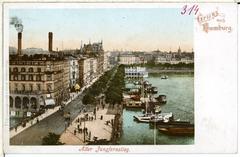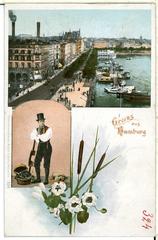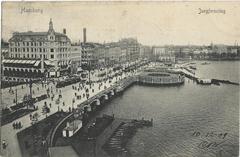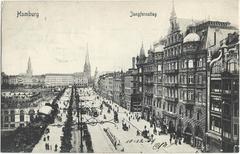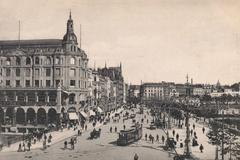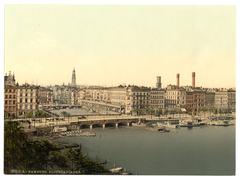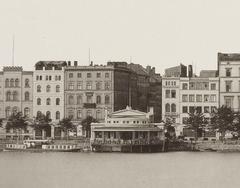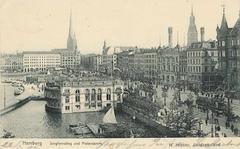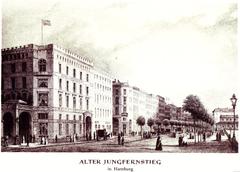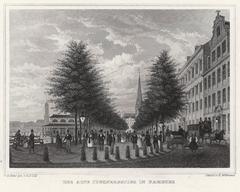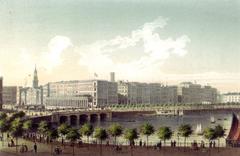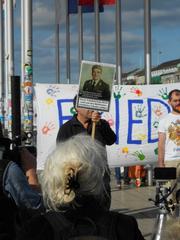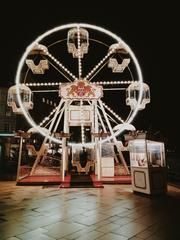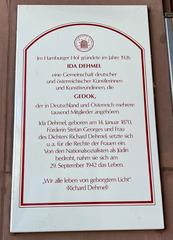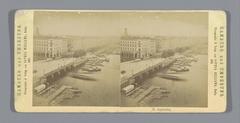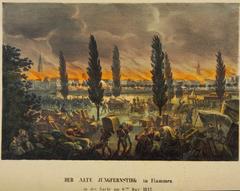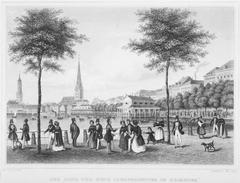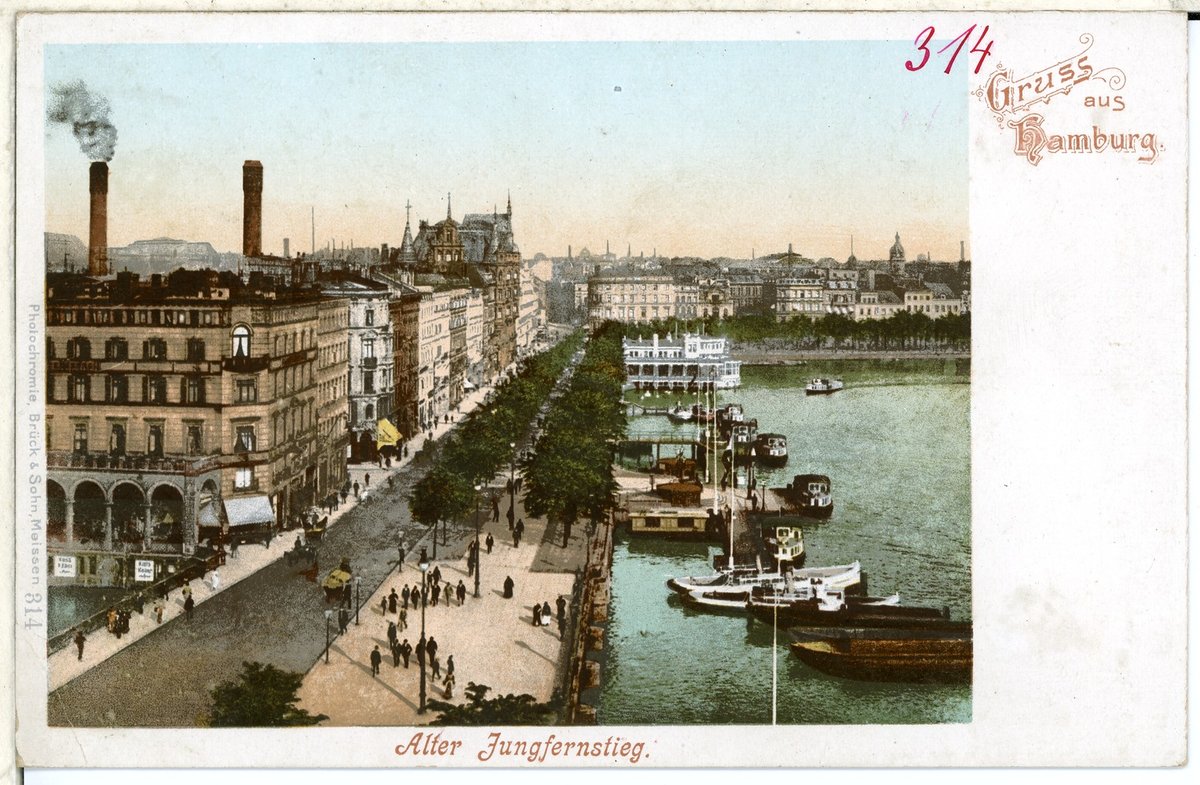
Jungfernstieg Hamburg: Visiting Hours, Tickets, and Historical Sites Guide
Date: 14/06/2025
Introduction
Jungfernstieg is Hamburg’s most iconic boulevard, seamlessly blending deep historical roots with modern urban vibrancy. Stretching along the southern shore of the Binnenalster (Inner Alster Lake), it has evolved from a medieval dam into a cosmopolitan hub for shopping, leisure, and culture. Its name, inspired by the 19th-century custom of promenading unmarried daughters (“Jungfern”), reflects its enduring association with elegance and social life (hamburgspezial.de; nomadepicureans.com).
Jungfernstieg is renowned as Germany’s first asphalted street (1838), a testament to Hamburg’s innovative spirit. Today, it is celebrated for its unique mix of historic architecture, luxury shopping, scenic views, and vibrant events—from the Musikfest Jungfernstieg to the beloved Winterzauber Christmas market (hamburg-tourism.de; hamburgspezial.de). This guide covers Jungfernstieg’s rich history, visiting hours, accessibility, nearby attractions, and recent urban renewal efforts for an optimized and memorable visit.
Table of Contents
- Historical Overview
- Visiting Jungfernstieg: Practical Information
- Recent Developments and Urban Renewal
- Events and Festivals
- Frequently Asked Questions (FAQ)
- Conclusion
- References
Historical Overview
Medieval Origins and Early Development
Jungfernstieg traces its beginnings to the early 13th century when Hamburg dammed the Alster River (1235) to create the Binnenalster, transforming what was then called the “Reesendamm” (hamburgspezial.de; travelsetu.com). This infrastructure supported the city’s economic growth, providing water power and establishing Hamburg as a Hanseatic trading center.
Transformation into a Promenade and Naming
As Hamburg prospered, the Reesendamm area became a social destination by the 18th–19th centuries. The tradition of affluent families walking their unmarried daughters along the promenade on Sundays gave rise to the name “Jungfernstieg” (“Maiden’s Walkway”) and established the boulevard’s reputation for elegance and social connection (nomadepicureans.com; hamburg-travel.com).
19th–20th Century: Urbanization, War, and Commercial Flourishing
Jungfernstieg’s modernization peaked when it became the first asphalted street in Germany (1838), heralding a wave of urban development (hamburgspezial.de). The boulevard soon featured grand architecture, luxury boutiques, and cultural venues. The Alsterpavillon, since 1799, became a social landmark (travelsetu.com).
Suffering heavy damage during WWII, the boulevard underwent extensive post-war reconstruction, blending historic façades with modern design (hamburgtouring.com). The Hamburger Hof, for example, was rebuilt and now houses a shopping arcade. The 1987 inauguration of the Alster Fountain further enhanced Jungfernstieg’s visual appeal (travelsetu.com).
Cultural Significance
Jungfernstieg is regarded as Hamburg’s “good parlor” and social heart (hamburg.de). It is home to flagship stores, iconic cafés, and luxury boutiques such as the Alsterhaus and Hamburger Hof (hamburgtouring.com). Throughout the year, events like the Musikfest Jungfernstieg and Winterzauber Christmas market transform the promenade into a lively cultural stage (hamburg-tourism.de).
Visiting Jungfernstieg: Practical Information
Visiting Hours and Accessibility
- Promenade: Open 24/7 all year.
- Shops & Cafés: Generally 10:00 AM–8:00 PM (Monday–Saturday), with some variations during holidays and events.
- Accessibility: Recent upgrades include wide, smooth pavements, ramps, tactile paving, and accessible public transport at Jungfernstieg station (U-Bahn, S-Bahn, and bus lines) (radiohamburg.de).
Tickets and Tours
- Public Promenade: Free access.
- Boat Tours: Tickets required; available at the Alsteranleger pier or online. Boats operate mainly April–October (hamburg.de).
- Guided Tours: Walking and historical tours can be booked via local operators and official websites.
- Nearby Attractions: Some, like Hamburg Rathaus, require tickets for guided tours.
Best Time to Visit and Travel Tips
- Best seasons: Late spring to early autumn for outdoor activities and festivals; December for Christmas markets.
- Tips:
- Visit early morning or weekdays for quieter strolls.
- Enjoy panoramic views from Alsterpavillon or Alsterhaus rooftop.
- Carry some cash, though cards are accepted widely.
- Use public transport for hassle-free access.
Nearby Attractions
- Binnenalster & Außenalster: Ideal for boating and walks.
- Hamburg Rathaus (City Hall): Neo-Renaissance masterpiece open for tours.
- Mönckebergstraße: Major shopping street.
- Planten un Blomen Park: Central city park for relaxation.
- Speicherstadt: UNESCO warehouse district, easily reached by foot or boat.
Recent Developments and Urban Renewal
Jungfernstieg has seen major upgrades as part of Hamburg’s urban transformation. The €13.4 million redevelopment (completed May 2025) prioritized pedestrian and cyclist safety, expanded green spaces, and introduced family-friendly features like trampolines, a mist field, and a dance chime (hamburg.de). Traffic is now limited to public transport and essential vehicles, creating a calm, community-oriented atmosphere. Accessibility improvements include step-free routes and tactile guidance.
Environmental initiatives feature new tree plantings and smart waste management. Digitalization brings free public Wi-Fi, real-time info kiosks, and adaptive LED lighting for safety and energy efficiency.
Events and Festivals
Jungfernstieg is a year-round venue for Hamburg’s major events and cultural happenings:
- Musikfest Jungfernstieg: Open-air concerts spanning jazz, pop, and classical music (hamburg-tourism.de).
- Winterzauber Christmas Market: Festive stalls, illuminated Alster ships, and traditional Märchenschiffe (“fairy-tale ships”) (hamburgspezial.de).
- Other Festivals: CSD-Straßenfest (Hamburg Pride), Mobility Festival, and seasonal art installations (hamburg-travel.com).
Frequently Asked Questions (FAQ)
Q: What are Jungfernstieg’s visiting hours?
A: The promenade is open 24/7. Shops and cafés typically operate from 10:00 AM to 8:00 PM.
Q: Do I need a ticket to visit Jungfernstieg?
A: No, access is free. Boat tours and some attractions require tickets.
Q: Is Jungfernstieg accessible for those with disabilities?
A: Yes—upgraded pavements, ramps, tactile paving, and accessible public transit are available.
Q: How can I get there?
A: Use Jungfernstieg station (U-Bahn: U1, U2, U4; S-Bahn: S1, S2, S3). Public transport is recommended.
Q: Are guided tours available?
A: Yes, including historical walking tours and boat cruises.
Q: What are some must-see sights nearby?
A: Binnenalster lake, Hamburg Rathaus, Planten un Blomen Park, Speicherstadt, and Mönckebergstraße.
Conclusion
Jungfernstieg encapsulates Hamburg’s evolution from its medieval origins to a modern, welcoming metropolis. Its scenic promenade, architectural landmarks, and lively cultural calendar offer a dynamic experience for every visitor. The latest urban renewal has enhanced accessibility, safety, and sustainability, ensuring Jungfernstieg remains an inclusive and engaging destination (hamburg.de).
For a richer experience, explore nearby attractions, join a guided tour, and attend one of the many events that animate this historic boulevard. Stay informed about the latest happenings by downloading the Audiala app and following official social media channels.
References
- This is a sample text. (hamburgspezial.de)
- This is a sample text. (nomadepicureans.com)
- This is a sample text. (hamburg-travel.com)
- This is a sample text. (hamburgtouring.com)
- This is a sample text. (hamburg-tourism.de)
- This is a sample text. (hamburg.de)
- This is a sample text. (radiohamburg.de)
- This is a sample text. (travelsetu.com)
